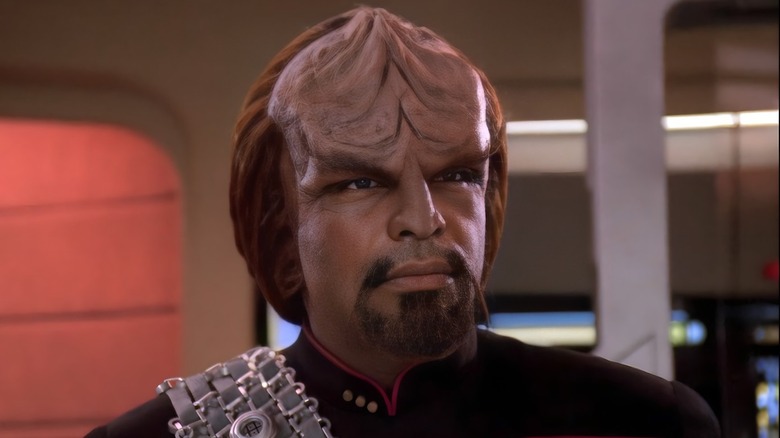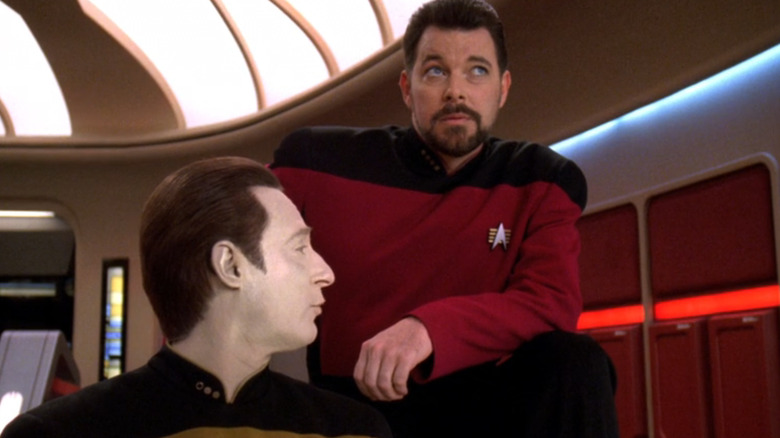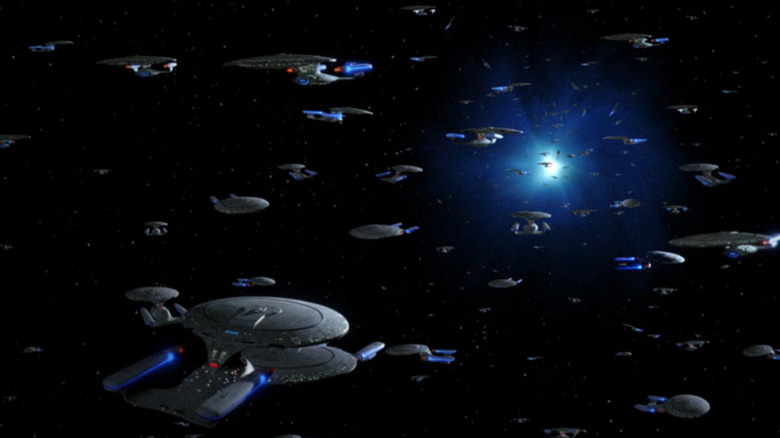Star Trek: The Next Generation's 'Parallels' Showed The Madness Of TNG's Multiverse
Multiverses are all the rage these days. The Marvel Cinematic Universe has been all-in on the concept post-"Endgame," spawning projects like "Doctor Strange in the Multiverse of Madness" and "Spider-Man: No Way Home." Speaking of the web-slinger, Sony's "Spider-Verse" movies have taken the concept in fascinating directions. And this year, a multiverse movie, "Everything Everywhere All at Once" took home best picture at the Oscars.
As usual, "Star Trek" is way ahead of the curve. The beloved science fiction franchise has been exploring the notion of a quantum multiverse since "Star Trek: The Original Series" in the 1960s. This was notably explored in the "Star Trek: The Original Series" episode "Mirror, Mirror," in which Captain Kirk (William Shatner) and Spock (Leonard Nimoy) find themselves transported to the Mirror Universe, an alternate dimension where the Federation is evil and, even more upsettingly, everyone sports goatees. Other episodes from both "The Original Series" and "Star Trek: The Next Generation" have examined multiverse concepts ranging from branching timelines to alternate existences. But it wasn't until the final season of "The Next Generation" that an in-world explanation of the multiverse emerged.
The Season 7 episode, "Parallels," finds Worf (Michael Dorn) returning from a bat'leth tournament to find himself slipping through multiple realities, including one in which he is married to Deanna Troi (Marina Sirtis) and Jean-Luc Picard (Patrick Stewart) is dead. Eventually, by flying a shuttle through the quantum fissure causing his displacement, Worf is able to return to his own reality, but not before hundreds of thousands of Enterprises are temporarily pulled into a single universe. By studying this episode, we can figure out the basic "rules" of the "Star Trek" multiverse. Spoiler alert: it doesn't make a lot of sense.
How do multiverses work in Star Trek?
Over the decades of "Star Trek" movies and TV shows, we've seen a lot of scenarios that could be termed multiverses. Often, they're framed as branching timelines resulting from time travel, such as in one of the best "Star Trek" episodes of all time, the classic "Star Trek: The Original Series" episode "The City on the Edge of Forever," which finds Kirk and Spock trapped in the New York City during the Great Depression after Leonard McCoy (DeForest Kelley) goes through a time portal. To keep the timeline intact, Kirk must make a horrible decision.
In "Parallels," the Worf-centric multiverse-hopping episode of "Star Trek: The Next Generation," the rules of the multiverse are made clear with the franchise's signature blend of semi-coherent sci-fi mumbo-jumbo. According to Data (Brent Spiner), each universe resonates at its own specific frequency along with everything in them, preventing them from overlapping into each other. While on return to the Enterprise in his own universe, Worf made the mistake of accidentally travelling through a "fissure" intersecting multiple universes, causing him to begin shifting his frequency into other realities.
The episode's explanation is shaky at best. Its internal logic is consistent (for the most part—more on that presently) but when taken in sum with other multiverse "Star Trek" stories, it all feels less coherent.
Is multiverse travel in Star Trek a mental or physical phenomenon?
One confusing aspect of "Parallels," the "Star Trek: The Next Generation" episode that explains how the multiverse works, is that it never clears up whether traversing between universes is a corporeal or metaphysical phenomenon. When Worf begins to find himself slipping between timelines, it seems like only his mind is being transferred. At one point, for example, his uniform is changed during the slip, which suggests it is Worf's consciousness rather than his physical body doing the multiverse-hopping. Yet by the end of the episode, hundreds of thousands of copies of the USS Enterprise make their way into the universe Worf is stuck inside, each containing its own Worf.
In fact, the prime Enterprise itself arrives in that universe, presumably containing the body of prime Worf. How can his consciousness be in another Worf while also in the body of the original? Is every version of Worf experiencing the same thing, with each of their consciousnesses hopping into different bodies? If so, what's going on with prime Worf, whose body remains onboard the prime Enterprise? The episode offers no answers.
Ultimately, "Parallels" demonstrates just how complex it is to tell a coherent multiverse-spanning story. The idea of the multiverse has yet to be empirically proven by science, which means writers are left to devise their own explanations and understanding of it. As more current-day multiverse stories are being told, it's clear that the concept has staying power, but the most successful versions of it, your "Across the Spider-Verse" or "Everything Everywhere All at Once," focus on characters over mechanics. "Parallels" is a fantastic episode of "Star Trek" because it focuses on Worf's friendships with the Enterprise crew, but it shows its own limits when trying to put forth a working scientific theory.


